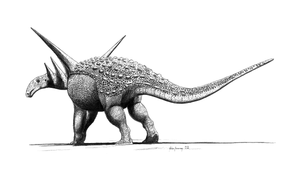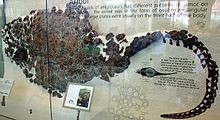Sauropelta
| Sauropelta | ||||||||||||
|---|---|---|---|---|---|---|---|---|---|---|---|---|

Reconstruction of the Sauropelta with exaggerated long shoulder spines |
||||||||||||
| Temporal occurrence | ||||||||||||
| Lower Cretaceous (late Aptian to early Albian ) | ||||||||||||
| 123 to 110.2 million years | ||||||||||||
| Locations | ||||||||||||
| Systematics | ||||||||||||
|
||||||||||||
| Scientific name | ||||||||||||
| Sauropelta | ||||||||||||
| Ostrom , 1970 | ||||||||||||
| Art | ||||||||||||
|
Sauropelta is a genus of pelvic dinosaurs from the Ankylosauria group . It is counted among the Nodosauridae , and is one of the oldest and at the same time bestpreserved fossil representatives. Sauropelta lived in the Lower Cretaceous in North America.
features
General
Sauropelta was one of the largest nodosaurids along with Panoplosaurus . Its length was up to 7.6 meters and its weight is estimated at 1.5 tons. Like all Ankylosauria it moved quadruped (on all fours). The torso was broad, the front legs shorter than the back legs. Overall, the limbs, as well as the shoulder and pelvic region, were very stocky. Sauropelta had a remarkably long tail, which made up about half the total length and consisted of at least 40 caudal vertebrae. The tail was reinforced by ossified tendons , as in all Nodosauridae there was no tail lobe.
Armor
Like all Ankylosauria, the Sauropelta was covered with armor made of bone scales (osteoderms). In contrast to many other ankylosaurs, the armor has been handed down in situ and is therefore well known. Two parallel rows of arched scales ran along the top of the neck. The top of the torso and tail were covered by small bones, with larger, conical scales in between, which ran in parallel, lengthwise rows. Above the pelvis , the bone scales grew together to form a shield-shaped structure, which is also found in Polacanthus , for example . Large, pointed spikes ran along the side of the neck and trunk, the largest were found in the shoulder area and became smaller again towards the back. Behind the pelvis ran flat, triangular plates that were arranged outwards and became smaller towards the tip of the tail.
skull
The skull , like that of all Nodosauridae, was roughly triangular in shape and had a pointed snout. The roof of the skull was flat and covered with dense, bony plates. There were thick triangular scales of bone on the back of the head and on the cheeks. Like all Ankylosauria, Sauropelta had small, leaf-shaped teeth that were adapted to a vegetable diet. The front part of the skull is not known; a horned beak may have been present.
Way of life
Sauropelta was a herbivore that, due to its posture, fed on plants up to 1 meter in height, such as conifers and cycads . The narrow snout could indicate that it was more selective in the choice of food than the Ankylosauridae, for example . The teeth were only partially suitable for chewing, the further splitting of the food probably took place in the voluminous trunk.
While the armor likely played a defensive role, the importance of the spikes is more controversial. In addition to defense purposes, interaction with conspecifics could also have been used, such as showing off in the fight for mating privilege.
Discovery and naming
Sauropelta fossil remains come from the Cloverly Formation in the US states of Wyoming and Montana and were first described by John Ostrom in 1970 . The name means "Schildechse" (from Greek σαῦρος / sauros (= "lizard" ') and πέλτη / peltē (= "shield")) and alludes to the strong armor. The only named species and thus type species is S. edwardsorum , but there are indications of other, so far not described species, for example by Kenneth Carpenter in 1999 in Utah .
The finds are dated in the Lower Cretaceous (late Aptian to early Albian ) to an age of 123 to 110 million years.
Systematics
Sauropelta is counted within the Ankylosauria to the group of Nodosauridae . It is probably closely related to Silvisaurus and Pawpawsaurus , with which it is one of the basal representatives of the Nodosauridae. It is one of the oldest undisputed representatives of the Nodosauridae, only Cedarpelta is even older.
literature
- Kenneth Carpenter : Skeletal reconstruction and life restoration of Sauropelta (Ankylosauria: Nodosauridae) from the Cretaceous of North America. In: Canadian Journal of Earth Sciences Vol. 21, No. 12, 1984, ISSN 0008-4077 , pp. 1491-1498, doi : 10.1139 / e84-154 .
- Kenneth Carpenter, James I. Kirkland : Review of Lower and Middle Cretaceous Ankylosaurs from North America. In: Spencer G. Lucas, James I. Kirkland, John W. Estep (eds.): Lower and Middle Cretaceous Ecosystems (= New Mexico Museum of Natural History and Science. Bulletin. Vol. 14, ISSN 1524-4156 ). New Mexico Museum of Natural History and Science, Albuquerque NM 1998, pp. 249-270, digitized .
- Matthew K. Vickaryous, Teresa Maryańska , David B. Weishampel : Ankylosauria. In: David B. Weishampel, Peter Dodson , Halszka Osmólska (eds.): The Dinosauria . 2nd edition. University of California Press, Berkeley CA et al. 2004, ISBN 0-520-24209-2 , pp. 363-392.
Individual evidence
- ^ Gregory S. Paul : The Princeton Field Guide To Dinosaurs. Princeton University Press, Princeton NJ et al. 2010, ISBN 978-0-691-13720-9 , p. 236, online .

